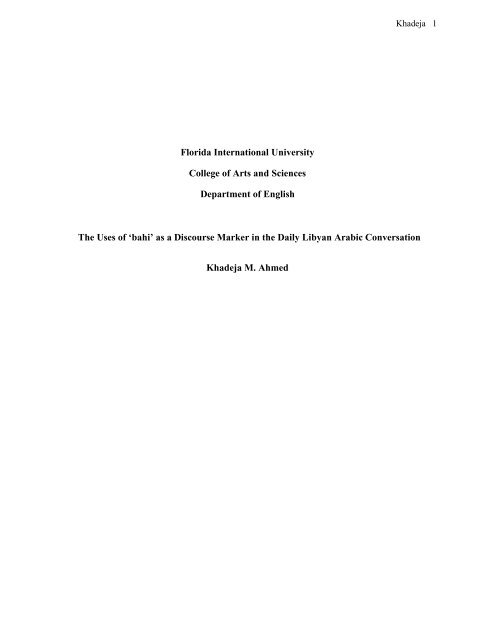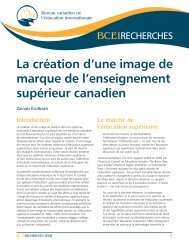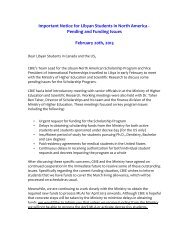Bahi-as-a -Discourse -Marker-in-Daily -Libyan-Arabic
Bahi-as-a -Discourse -Marker-in-Daily -Libyan-Arabic
Bahi-as-a -Discourse -Marker-in-Daily -Libyan-Arabic
You also want an ePaper? Increase the reach of your titles
YUMPU automatically turns print PDFs into web optimized ePapers that Google loves.
Khadeja 1Florida International UniversityCollege of Arts and SciencesDepartment of EnglishThe Uses of ‘bahi’ <strong>as</strong> a <strong>Discourse</strong> <strong>Marker</strong> <strong>in</strong> the <strong>Daily</strong> <strong>Libyan</strong> <strong>Arabic</strong> ConversationKhadeja M. Ahmed
Khadeja 2I. Introduction:When generally look<strong>in</strong>g at discourse markers, one can def<strong>in</strong>e them <strong>as</strong> l<strong>in</strong>guistic formsused to express ide<strong>as</strong> or convey pragmatic messages at a particular situation. They are there fora purpose and without them, many pragmatic <strong>in</strong>stances that help people understand what ismeant <strong>in</strong> such a particular way and <strong>in</strong>terpret the different utterances <strong>in</strong> a dialogue, will bemiss<strong>in</strong>g. <strong>Discourse</strong> markers, referred to <strong>as</strong> “DM” are generally def<strong>in</strong>ed <strong>as</strong> brief and frequentl<strong>in</strong>guistic expressions by which speakers deliver or receive a pragmatic message <strong>in</strong> the dialogue.(Popescu-Belis & Zufferey, 2011).The use of discourse markers h<strong>as</strong> a lot to do with use of language b<strong>as</strong>ed on context. Onecan use the same marker <strong>in</strong> different contexts convey<strong>in</strong>g different mean<strong>in</strong>gs. They aremonitored by various factors and are used for a re<strong>as</strong>on that is already perceived by both thespeaker and the hearer <strong>in</strong> different contexts.Additionally, discourse markers can be utilized and <strong>in</strong>terpreted contextually, but notnecessarily literally. Another important factor that monitors their use is the culture or theenvironment <strong>in</strong> which they are employed to serve a sociol<strong>in</strong>guistic function. Moreover, <strong>as</strong>ubconscious agreement from the <strong>in</strong>terlocutors about the way the discourse marker is used isanother important <strong>as</strong>pect.“<strong>Discourse</strong> markers are conjectured to give the hearer <strong>in</strong>formation about the discoursestructure, and so aid the hearer <strong>in</strong> understand<strong>in</strong>g how the new speech or text relates to what w<strong>as</strong>previously said and for resolv<strong>in</strong>g anaphoric references” (Hirschberg and Litman, 1993).However, In <strong>Libyan</strong> <strong>Arabic</strong>; a dialect of <strong>Arabic</strong>, discourse markers also play a major role<strong>in</strong> the perception and <strong>in</strong>terpretation of everyday speech. The dialect is so rich with variousl<strong>in</strong>guistic markers that function pragmatically. Speakers of <strong>Libyan</strong> get the advantage of us<strong>in</strong>g
Khadeja 3discourse markers b<strong>as</strong>ed on social <strong>as</strong>pects where culture and environment play an important role<strong>in</strong> perceiv<strong>in</strong>g the mean<strong>in</strong>g. In this paper, the focus will be on one discourse marker known <strong>as</strong>‘bahi’ pronounced <strong>as</strong> /bɑahi/ <strong>as</strong> a marker that carries various mean<strong>in</strong>gs and functions accord<strong>in</strong>gto the context <strong>in</strong> which it is used. In general, discourse markers are given particularcharacteristics to help identify them <strong>in</strong> a better way. Schourup (1999) lists some salient featurescharacteriz<strong>in</strong>g discourse markers and their functions such <strong>as</strong> connectivity, optionality, non-truthconditionality, weak clause <strong>as</strong>sociation, <strong>in</strong>itiality, orality, and multi-categorality.As for ‘bahi’, speakers can play with the word to give various mean<strong>in</strong>gs such <strong>as</strong>agreement, disagreement, warn<strong>in</strong>g, expectation more, request for cont<strong>in</strong>uance, show<strong>in</strong>gadmiration, blam<strong>in</strong>g, and end<strong>in</strong>g arguments. Also, ‘bahi’ plays a significant role <strong>in</strong> comb<strong>in</strong><strong>in</strong>gwhat the speaker <strong>as</strong> well <strong>as</strong> the hearer th<strong>in</strong>k about each other’s statements. That is, it is serv<strong>in</strong>g<strong>as</strong> a tool that reflects speakers’ ide<strong>as</strong> and what op<strong>in</strong>ions or reactions they may have towardssometh<strong>in</strong>g. Miri Husse<strong>in</strong> (1997) argued that discourse markers can help manifest<strong>in</strong>g theconnection between ide<strong>as</strong> and their organization <strong>in</strong> speech.The motivation beh<strong>in</strong>d this study is to reveal how rich and vibrant the <strong>Libyan</strong> dialect iswith many l<strong>in</strong>guistic markers that can take various roles <strong>in</strong> discourse b<strong>as</strong>ed on speakers’ notionsand society’s approval of any newly <strong>in</strong>vented use for any specific word.One clear th<strong>in</strong>g about the word ‘bahi’ is that when it w<strong>as</strong> first used, it did not have thedifferent contextual l<strong>in</strong>guistic mean<strong>in</strong>gs that it h<strong>as</strong> today. However, the number of uses<strong>in</strong>cre<strong>as</strong>ed <strong>as</strong> the speakers demanded more uses. The <strong>in</strong>terest<strong>in</strong>g th<strong>in</strong>g about this is the waypeople can manipulate the language <strong>in</strong> order to deliver different messages by us<strong>in</strong>g one word.This paper <strong>in</strong>vestigates the various uses of ‘bahi’ <strong>as</strong> an important discourse marker thattakes place <strong>in</strong> the daily speech of <strong>Libyan</strong> people <strong>in</strong> different situations and social levels.
Khadeja 4‘bahi’ is a multi-functional discourse marker that conveys different mean<strong>in</strong>gs. As statedby Lewis, 2006, there are three <strong>as</strong>pects suggested with reference to the relation between eachmarker’s various mean<strong>in</strong>gs and the semantic values that are represented <strong>in</strong> the lexicon; thehomonymy <strong>as</strong>pect, the pragmatic <strong>as</strong>pect, and the polysemy <strong>as</strong>pect. This applies to ‘bahi’ <strong>as</strong> welland will be reflected <strong>in</strong> the data analyzed below.In this paper, the uses of ‘bahi’ will be analyzed b<strong>as</strong>ed on two types of collected data;videos recorded at The Faculty of Arts, Sebha University, Libya 2008, show<strong>in</strong>g pairs ofstudents shar<strong>in</strong>g a discussion over a t<strong>as</strong>k given to them and us<strong>in</strong>g ‘bahi’ <strong>as</strong> a l<strong>in</strong>guistic marker.The other is a collection of written <strong>Libyan</strong> conversations made over the phone and <strong>in</strong> person.Each data will be transcribed <strong>in</strong> the form of extracts followed by analysis of how ‘bahi’w<strong>as</strong> utilized with<strong>in</strong> the context and if there are any other related phenomena <strong>as</strong>sociated with‘bahi’.II.Data Analysis:Part I. Video Recorded Data:The data collected w<strong>as</strong> recorded at the faculty of Arts, Sebha University, 2008 <strong>in</strong> aworkshop under the supervision of the International Association of Pragmatics. Studentscontribut<strong>in</strong>g <strong>in</strong> this data were a mix of undergraduates pursu<strong>in</strong>g their BA <strong>in</strong> English Language.Each pair of students w<strong>as</strong> given a random set of story sequences to rearrange and talk about <strong>as</strong>they work. For the purpose of this paper, only the utterances where ‘bahi’ w<strong>as</strong> used are the onesrelevant to the study, and hence were shared here. The three follow<strong>in</strong>g extracts written <strong>in</strong> <strong>Arabic</strong>with translation reflect various contextual mean<strong>in</strong>gs of the word:Extract 1. (First l<strong>in</strong>e <strong>in</strong> <strong>Arabic</strong> is the actual utterance, the second, <strong>in</strong> English, is the mean<strong>in</strong>g)هذه الأولى، اول وحدة، التانية..أهي ا .aThe first one, First one, the second. Here it is
Khadeja 5باهى .b<strong>Bahi</strong>…third, this (agreement)لا .aNo...التالتة..هذ هآهى .bHere it isاستنى هما مع بعض .aWait they are togetherهما مختلفين، أهى، البيضاء مع الرمادية والصفراء مع الرمادية..أهيا .bThey are different, Here it is, white and grey and yellow and grey, here it isلا، هنا .ab. No, hereايه .aYesلا، البيضاء مع .bNo white with ..ايه .aYeahلا ، لا .bNo, noهذه هنا .aThis is hereباهى...بعدين؟ .b<strong>Bahi</strong>…then..(Wait<strong>in</strong>g for response)Analysis:As noted above, two uses of ‘bahi’ were used; from the first one, we can <strong>in</strong>fer that‘bahi’ <strong>in</strong>dicated agreement; the agreement of the hearer to what the speaker said without any
Khadeja 6type of objection so that the speaker can either switch to another step or let the hearer do that.Alternatively, <strong>in</strong> the second use, ‘bahi’ w<strong>as</strong> used <strong>in</strong> a different context and hence gave adifferent mean<strong>in</strong>g. When the hearer said ‘bahi’ here, she took what the speaker h<strong>as</strong> already said<strong>in</strong>to a consideration but still the <strong>in</strong>formation w<strong>as</strong> not enough for her, that is why she said ‘bahi’mean<strong>in</strong>g ‘then….?’ <strong>as</strong>k<strong>in</strong>g the speaker <strong>in</strong>directly to add more <strong>in</strong>formation <strong>as</strong> needed. So the twofunctions above reflect how ‘bahi’ w<strong>as</strong> used but <strong>in</strong> two different contexts giv<strong>in</strong>g two differentmean<strong>in</strong>gs. It is by the help of discourse markers that speakers can <strong>in</strong>terpret utterances and usethem for many purposes such <strong>as</strong> politeness, disagreement, and gap fill<strong>in</strong>g <strong>in</strong> a coherent way.(Brennan & Williams, 1995).Extract 2.شوفى اول وحدة هذه ، وبعدين القى عصا باه ى؟ .aLook, this is the first one, and then he found a stick, bahi?حطى الصورة اهيا .bPut this pictureلا ، هذه نفسها ، هده القاها طايحة آه ، صح باهى .aNo, this is the same; he found it thrown (the stick) aha, right bahiباهى ، بعد تكسرت العصا وهنا بيقفز معناها هذه قبل ، ريتى ؟ معناها هذه قبل .b<strong>Bahi</strong>.., after the stick w<strong>as</strong> broken, here he wanted to jump; which means this one isbefore that one, see? It means this one is first.Analysis:As noted above, ‘bahi’ first w<strong>as</strong> used to express the speaker’s doubt if the hearerunderstood or not; that is why she says ‘bahi?’ with a ris<strong>in</strong>g tone but <strong>in</strong> a polite formal mannerexpect<strong>in</strong>g the hearer to reply <strong>in</strong> return say<strong>in</strong>g ‘bahi’ with a fall<strong>in</strong>g tone to <strong>as</strong>sure the speaker’sdoubt. However, <strong>in</strong> the second situation, ‘bahi’ w<strong>as</strong> used by the speaker to state her <strong>in</strong>itialagreement with her own choice before gett<strong>in</strong>g the reaction of the hearer; she says ‘bahi’ so that
Khadeja 7the hearer <strong>in</strong>fers that the speaker is already conv<strong>in</strong>ced with her choice. F<strong>in</strong>ally, ‘bahi’ w<strong>as</strong> usedb<strong>as</strong>ed on a previous agreement between the two speakers, by then one speaker will say ‘bahi’which means ‘accord<strong>in</strong>gly’ or ‘b<strong>as</strong>ed on that’, then a consequence of all what took place willcome out. That is, the speaker above repeats the previously observed note <strong>in</strong> the story and uses‘bahi’ <strong>as</strong> a marker of reference to that and employs that <strong>in</strong> her f<strong>in</strong>d<strong>in</strong>gs about what is go<strong>in</strong>g tohappen next. Accord<strong>in</strong>gly, the marker w<strong>as</strong> used each time <strong>in</strong> a way that is relevant to the context.Husse<strong>in</strong> (2007) refers to relevance <strong>as</strong> an approach that connects thoughts and <strong>in</strong>tentions ratherthan the expressed l<strong>in</strong>guistic forms.Extract 3ايه الأولى كان ماشى وبعدين هذه .aYes at first he w<strong>as</strong> walk<strong>in</strong>g, then thisباهى ، اوكى ، b.<strong>Bahi</strong>! (Ok!)كلهن ماشى .aHe is go<strong>in</strong>g <strong>in</strong> all of themايه ، حتى هذا دايرينه هذا ماشى هكى ، انقولوا باهى متلاَ لما بينط وهذا امولى هكى ، ترا هديكا ، ترا هديكا ؟ .bYes, even this, they made him go this way, ‘bahi’ (<strong>in</strong> c<strong>as</strong>e) for example we can say thatwhen he tries to jump and <strong>in</strong> this one he is com<strong>in</strong>g back , show me that one , show methat one.Analysis:In the conversation above, ‘bahi’ w<strong>as</strong> first used giv<strong>in</strong>g the mean<strong>in</strong>g of ‘ok!’ or ‘f<strong>in</strong>e!’;giv<strong>in</strong>g the impression that <strong>in</strong>itially, the hearer doesn’t m<strong>in</strong>d what she heard but still she is fullyconv<strong>in</strong>ced of her own op<strong>in</strong>ion which may cause the speakers to go through further discussionuntil one of them is conv<strong>in</strong>ced by the other. The second use of ‘bahi’ w<strong>as</strong> used <strong>as</strong> ‘<strong>in</strong> c<strong>as</strong>e of, thatis, <strong>in</strong> c<strong>as</strong>e someth<strong>in</strong>g happened, then a consequent event is expected to happen too. In other
Khadeja 8words, someth<strong>in</strong>g will not happen unless a particular other th<strong>in</strong>g happened. The first use isrelated to <strong>in</strong>itiality characteristic of discourse marker <strong>in</strong>troduc<strong>in</strong>g the mean<strong>in</strong>g they mark. Thelatter use is related to the connectivity characteristic by which the marker <strong>in</strong>dicates theconnectivity between the discourse components. The two above characteristics were amongst thediscourse markers characteristics listed by Schourup (1999).Part II. Conversations:Another important factor that serves <strong>as</strong> a b<strong>as</strong>is for us<strong>in</strong>g ‘bahi’ <strong>as</strong> a marker to convey <strong>as</strong>pecific message is the age difference between the <strong>in</strong>terlocutors. In other words, ‘bahi’s use maybe used by a speaker with an attribute of authority when address<strong>in</strong>g anther speaker who isyounger. The follow<strong>in</strong>g conversations were collected through record<strong>in</strong>g and writ<strong>in</strong>g. The figuresof the dialogue were selected b<strong>as</strong>ed on age difference; two sisters with different age range of 25-30. The dialogues below will reflect how the use of ‘bahi’ can be employed to show thisdifference <strong>in</strong> reference to responsibility, power, and age hierarchy.Dialogue I. ((a) The younger sister, (b) the older sister)باهى من الوجوه الجديدة؟ .a<strong>Bahi</strong>, (so) any new faces?لا .bNoه...ياہلل مش مشكلة .aBah.. (Never m<strong>in</strong>d) no problemباهى الشغل منتظم؟<strong>Bahi</strong> (then) work is go<strong>in</strong>g well?ايه منتظم .bYes, it is go<strong>in</strong>g wellباهى باه .a<strong>Bahi</strong>, bah* (great)
Khadeja 9Analysis:‘bahi’ w<strong>as</strong> first used <strong>as</strong> ‘so' that is, <strong>as</strong> a transition from a previous po<strong>in</strong>t to a new one. Thesecond use of ‘bahi’ w<strong>as</strong> the result of know<strong>in</strong>g that there is noth<strong>in</strong>g impressive or <strong>in</strong>terest<strong>in</strong>g toknow, therefore, ‘bahi’ here comes <strong>as</strong> ‘never m<strong>in</strong>d’ followed by ‘no problem’. The l<strong>as</strong>t use of‘bahi’ above expresses admiration of the hearer of someth<strong>in</strong>g she heard and liked and said with aris<strong>in</strong>g tone ‘bahi, bah’. The second ‘bah’ w<strong>as</strong> said with the deletion of the l<strong>as</strong>t vowel /i/ and thatis because it w<strong>as</strong> said <strong>in</strong> a f<strong>as</strong>t causal speech.Dialogue II. ((a) The younger sister, (b) the older sister)تمشى معايا للسوق؟ .aWould you like to go shopp<strong>in</strong>g with me tonight?لالا مشغولة .bNo, no, I’m busyباهى، باه .a<strong>Bahi</strong>, bah (Blam<strong>in</strong>g)مشغولة .bI’m really busy and I don’t have time for that, sorry!بكل وما عنديش وقت، معليشباهى، شن رايك نمشوا غدوة؟ .a<strong>Bahi</strong>, (then) how about tomorrow?بصراحة ، هالأسبوع كله ما نقدر...لو الأسبوع الجاى ممكن .bFrankly, this week, I can’t, next week I might be able toباهى باهى، خلاص مانبيش نمشى ، غيرت رأي .a<strong>Bahi</strong>, bahi (forget about it)…..I changed my m<strong>in</strong>d, I don’t want to go at all!Analysis:In this dialogue, ‘bahi’ w<strong>as</strong> first used <strong>as</strong> an expression for blam<strong>in</strong>g. That is, the speaker didn’texpect the hearer to refuse her request and thus blamed her say<strong>in</strong>g ‘bahi bah’ with a change <strong>in</strong>her voice. However, <strong>in</strong> the second utterance, the speaker reschedules a time that might work for
Khadeja 10the hearer, but aga<strong>in</strong> the hearer apologizes and give her re<strong>as</strong>on for refus<strong>in</strong>g and offer <strong>as</strong>uggestion to postpone go<strong>in</strong>g shopp<strong>in</strong>g to next week which doesn’t receive a positive reactionfrom the speaker and hence the speaker says ‘bahi bah’ with anger stat<strong>in</strong>g that she is not<strong>in</strong>terested <strong>in</strong> go<strong>in</strong>g at all and that is where she said ‘I changed my m<strong>in</strong>d, I don’t want to go at all’.Dialogue III.خيرك ما اتردى على التليفون؟ قلقت عليك .aWhy didn’t answer my call? I w<strong>as</strong> so worried about you!الموسيقى كانت عالية وما سمعت الرنة .bThe music w<strong>as</strong> so loud <strong>in</strong> the car that I couldn’t hear the phone r<strong>in</strong>g<strong>in</strong>g.با .aBah bah! (Warn<strong>in</strong>g) So you turn up the music so high! I told many times not to dothat while driv<strong>in</strong>g! So shall I take the keys from you now??هى باه..صار اتعلى فى المسجلة ؟ وكم مرة قتلك انى ما اتعليش الصوت واجد..يعنى توا انقول احسن؟؟لالا، المرة الجاية مش حنعليها خلاص .bNo, next time I will not turn it this loud at all, I promise!كان عاودتيها معناها مافيش سواقة..باهى؟ .aIf you did it aga<strong>in</strong>, then no driv<strong>in</strong>g! <strong>Bahi</strong>? (Understand?)باهى باهى .b<strong>Bahi</strong> , bahi, (Ok)Analysis:As noted above, ‘bahi’ w<strong>as</strong> first used to express a warn<strong>in</strong>g tone from the speaker to the hearerafter she gave an unserious response while the speaker w<strong>as</strong> so concerned. As the speaker w<strong>as</strong>older <strong>in</strong> age, she simply used this type of ‘bahi’ send<strong>in</strong>g a warn<strong>in</strong>g to the hearer who will e<strong>as</strong>ilyperceive it. The second use of ‘bahi’ above serves <strong>as</strong> an expression by which the speaker isseek<strong>in</strong>g the hearer’s understand<strong>in</strong>g for what she h<strong>as</strong> requested <strong>in</strong> the form of <strong>in</strong>struction to theyounger sister and after that the hearer replies back and say ‘bahi bahi’ twice <strong>as</strong>sur<strong>in</strong>g thespeaker that she understood that and she will not repeat what she h<strong>as</strong> done before <strong>in</strong> order not toget her older sister angry with her.
Khadeja 11III.ObservationsFrom all of the above, it is quite obvious that ‘bahi’ can be used <strong>in</strong> different situations accord<strong>in</strong>gto the speakers’ <strong>in</strong>tentions to deliver certa<strong>in</strong> messages that are expected to be perceived by thehearer. In the future, ‘bahi’ may develop other contextual mean<strong>in</strong>gs <strong>as</strong>signed the way <strong>in</strong> whichspeakers want it to be used. Aga<strong>in</strong>, the role that ‘bahi’ <strong>as</strong> a discourse marker plays is so helpfulthat it saves a lot of effort for the speakers <strong>in</strong> perceiv<strong>in</strong>g the mean<strong>in</strong>g without hav<strong>in</strong>g to say it <strong>in</strong>literal longer words. ‘bahi’ <strong>as</strong> a discourse marker is function<strong>in</strong>g <strong>in</strong> the same way other discoursemarkers are. <strong>Discourse</strong> markers help speakers to <strong>in</strong>terpret one utterance b<strong>as</strong>ed on the <strong>in</strong>formationga<strong>in</strong>ed from a prior utterance which is referred to <strong>as</strong> “local coherence” where l<strong>in</strong>guistic andstructural function of discourse markers is to enhance the coherence of discourse. Schiffr<strong>in</strong>,(1987). On a sociol<strong>in</strong>guistic b<strong>as</strong>is, ‘bahi’ use will cont<strong>in</strong>ue to be used b<strong>as</strong>ed on speakers’ choiceand perception of social norms such <strong>as</strong> that of age difference <strong>as</strong> noted <strong>in</strong> the data where olderspeakers use ‘bah’ form perspectives that are different from a speaker who is younger which isb<strong>as</strong>ically b<strong>as</strong>ed on the higher social status elderly or those older <strong>in</strong> age reta<strong>in</strong> the advantage of‘bahi’ <strong>as</strong> well <strong>as</strong> other sociol<strong>in</strong>guistic phenomena. Also, ‘bahi’ is <strong>as</strong>signed different rolesaccord<strong>in</strong>g to speakers’ social perception <strong>in</strong> general.IV.ConclusionAs mentioned above, ‘bahi’ may take other roles and <strong>as</strong> a result <strong>in</strong>dicate further variousmean<strong>in</strong>gs <strong>in</strong> the future b<strong>as</strong>ed on the high frequency <strong>in</strong> which it is used now and the speakers’agreement on any use <strong>in</strong> the sociol<strong>in</strong>guistic context. As for this paper, it is worth mention<strong>in</strong>g thatthe videos data collected were not solely recorded to <strong>in</strong>vestigate ‘bahi’ but ‘bahi’ w<strong>as</strong> among thel<strong>in</strong>guistic forms that were observed <strong>in</strong> the <strong>Libyan</strong> speech and w<strong>as</strong> chosen <strong>as</strong> one of the topics thatare worth to be studied. Accord<strong>in</strong>gly, further work on the uses of ‘bahi’ <strong>in</strong> wider contexts and
Khadeja 12with larger amount of data can manifest the other important functions that ‘bahi’ is serv<strong>in</strong>g nowand the benefit speakers can ga<strong>in</strong> form the word when it comes to deliver<strong>in</strong>g or perceiv<strong>in</strong>g apragmatic message. Additionally, it can show the other possible uses the word can have. Also, anoteworthy factor <strong>in</strong> analyz<strong>in</strong>g the uses of the word is by collect<strong>in</strong>g large amount of notes anddata on how the word is naturally used between <strong>in</strong>terlocutors either by mak<strong>in</strong>g <strong>in</strong>terviews,watch<strong>in</strong>g how speakers use it <strong>in</strong> the different situations on a daily b<strong>as</strong>is where the focus is ‘bahi’only.
Khadeja 13ReferencesBrennan, S.E., & Williams, W. (1995) “The feel<strong>in</strong>g of another’s know<strong>in</strong>g: prosody and filledpauses <strong>as</strong> cues to listeners about the metacognitive states of speakers.” Journal ofmemory and Language 34: 383-398Hirschberg, Julia and Diane L. (1993). Empirical studies on the disambiguation of cue phr<strong>as</strong>es.Computational L<strong>in</strong>guistics 19: 501–30Husse<strong>in</strong>, M. (1997). Two accounts of discourse markers <strong>in</strong> English. University of Dam<strong>as</strong>cus,Syria.Schiffr<strong>in</strong>, D. (1987). <strong>Discourse</strong> markers. Cambridge: Cambridge University Press.Schourup, L. 1999. <strong>Discourse</strong> <strong>Marker</strong>s. L<strong>in</strong>gua 107: 227-265.Lewis, D. 2006. <strong>Discourse</strong> markers <strong>in</strong> English: a discourse-pragmatic view. In: Kerst<strong>in</strong> FischerApproaches to <strong>Discourse</strong> Particles. Amsterdam: Elsevier.Popescu-Belis A. & Zufferey S. (2011) - Automatic Identification of <strong>Discourse</strong> <strong>Marker</strong>s <strong>in</strong>Multiparty Dialogues: An In-Depth Study of Like and Well. Computer Speech andLanguage. 25: 499-518.
















